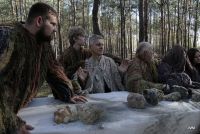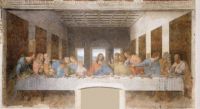Toruń. Wystawa "Dziennik Podróży z Ostatnią Wieczerzą"

Ostatnia wieczerza – performans 18.04.2019 r.
 W tym roku mija dokładnie 500 lat od śmierci wielkiego humanisty Leonarda da Vinci. W zadumie Wielkiego Tygodnia poddaliśmy się kontemplacji obrazu Ostatniej Wieczerzy. Podążając za historią biblijną, a także za motywem pożegnania w kulturze i sztuce przygotowaliśmy performans. Aktorzy na proscenium Dużej sceny będą prowadzili działania zapętlone przez 3 godziny między 16 a 19 w Wielki Czwartek.
W tym roku mija dokładnie 500 lat od śmierci wielkiego humanisty Leonarda da Vinci. W zadumie Wielkiego Tygodnia poddaliśmy się kontemplacji obrazu Ostatniej Wieczerzy. Podążając za historią biblijną, a także za motywem pożegnania w kulturze i sztuce przygotowaliśmy performans. Aktorzy na proscenium Dużej sceny będą prowadzili działania zapętlone przez 3 godziny między 16 a 19 w Wielki Czwartek.
Przedsięwzięcie w ramach projektu malarza i scenografa Jerzego Murawskiego pod tytułem „Dziennik Podróży z Ostatnią Wieczerzą”. Kostiumy wykorzystane na scenie będą pochodziły z rozwijanej przez artystę w ostatnich latach instalacji poświęconej żywemu obrazowi Ostatniej Wieczerzy.
„Było to przed Świętem Paschy. Jezus wiedząc, że nadeszła Jego godzina (…), umiłowawszy swoich na świecie, do końca ich umiłował. W czasie wieczerzy, gdy diabeł już nakłonił serce Judasza Iskarioty, (…) aby go wydać, wiedząc, że Ojciec dał Mu wszystko w ręce oraz że od Boga wyszedł i do Boga idzie, wstał od wieczerzy i złożył szaty. A wziąwszy prześcieradło nim się przepasał. Potem nalał wody do miednicy. I zaczął umywać uczniom nogi i ocierać prześcieradłem, którym był przepasany…” J13, 1-5 (Biblia Tysiąclecia)
Reżyseria: Paweł Paszta
Scenografia: Jerzy Michał Murawski
Wystąpią aktorzy i aktorki z zespołu Teatru im. Wilama Horzycy w Toruniu
18.04 w godz. 16-19 (wstęp w dowolnym momencie)
Wstęp 1zł
„Requiem dla Ostatniej Wieczerzy”, Jerzy Michał Murawski
Kolejny rozdział „Dziennika Podróży z «Ostatnią Wieczerzą»”, który prowadzę już od wielu lat, to: „Requiem dla Ostatniej Wieczerzy”. Rzecz na wiatr i piasek, pustkę i nieobecność, dzwony i lament. Posługując się wybranymi środkami artystycznymi mam zamiar udramatyzować Ostatnią Wieczerzę i w formie instalacji dźwiękowo-wizualnej pokazać ją jako rodzaj misterium paschalnego.
„Requiem dla Ostatniej Wieczerzy” jest przede wszystkim tragicznym obrazem fiaska wspólnej wieczerzy i porozumienia przy stole, obrazem zdrady człowieka i jego ideałów, wyparcia się wyznawanych wartości i w końcu zaparcia się samego siebie. Jest miejscem pustki i nieobecności, miejscem gdzie płaczki lamentują nad pogrzebanymi marzeniami człowieka, piasek zasypuje to, co pozostało z jego wzniosłych i wielkich idei i ideałów, a wiatr złowieszczo porusza wielkimi całunami. Miłość bliźniego, solidarność i empatia ponoszą tutaj gigantyczną klęskę. Chrystus-Człowiek pozostaje tragicznie samotny.
Niezrozumiany, zdradzony i opuszczony, samotny ze swoim przeznaczeniem.
Tradycja świąt wielkanocnych sprzyja zadumie i stymuluje do przemyśleń o przemijaniu, śmierci i cierpieniu. „Requiem dla Ostatniej Wieczerzy” ma w założeniu wywoływać emocje i kreować przestrzeń stymulującą do głębszych refleksji i zadawania sobie trudnych pytań. W naszej codziennej krzątaninie w poszukiwaniu chleba powszedniego nie powinno zabraknąć chwili poświęconej na zadumę nad naszym losem. Myślę, że potrzeba refleksji, którą ma wywoływać „Requiem dla Ostatniej Wieczerzy”, jest dostatecznie uzasadniona, zwłaszcza w czasie Wielkiego Tygodnia, wypełnionego dramatycznymi wydarzeniami, tak niezwykle ważnymi dla historii człowieka.
Okres Wielkiego Tygodnia jest okresem, w czasie którego najmocniej dramatyzowano liturgię i już od X wieku powstał pewien rodzaj „teatru liturgicznego”. Kiedyś podczas Wielkiego Postu zawieszano w kościołach wielkie płótna postne. W średniowieczu zasłonięcie tkaniną ołtarza, obrazów, krzyża i relikwiarzy było aktem rezygnacji z tego, co szczególnie istotne - możliwości oglądania liturgii.
„Requiem dla Ostatniej Wieczerzy” jest moją artystyczną wizją tego wydarzenia i sumą refleksji i przemyśleń, które towarzyszyły mi w prowadzonym przeze mnie dzienniku. Oglądających chciałbym przywitać słowami Jezusa:
„Wstańcie, chodźmy, oto zbliża się mój zdrajca”.
Dziennik Podróży z "Ostatnią Wieczerzą" w Dworze Artusa w Toruniu. Wystawa fotogramów i instalacja teatralna. Czerwiec-sierpień 2013
Zaplanowana instalacja, wydanie katalogu i wystawa fotogramów w Dworze Artusa w Toruniu mają być wydarzeniami artystycznymi w ramach kontynuacji prowadzonego przeze mnie od wielu lat „Dziennika Podróży z «Ostatnią Wieczerzą»” - cyklu instalacji teatralnych opartych na dziele Leonardo da Vinci.
Wystawa fotogramów jak i katalog ilustrujący „Dziennik Podróży z «Ostatnią Wieczerzą»” mają na celu pokazanie obecnego etapu pracy i udostępnienie jego rezultatów szerokiej publiczności. Centralnym punktem pokazu będzie zaplanowana przeze mnie skomplikowana instalacja „Ostatniej Wieczerzy” wg Leonardo da Vinci, zainscenizowana przy pomocy zaprojektowanych i wykonanych przeze mnie kostiumów, „ożywiona” światłem i dźwiękiem, umiejscowiona w specjalnie zaaranżowanej przestrzeni
Projekt otrzymał wsparcie finansowe w formie Stypendium Artystycznego Marszałka Województwa Kujawsko-Pomorskiego na okres styczeń-czerwiec 2013 roku.
Relacja z wystawy do obejrzenia na stronach:
The Diary of a Journey with The Last Supper
The Diary of the Journey with The Last Supper grew out of my fascination with Leonardo Da Vinci's work and the subject of the Last Supper – one that has been the focus of the efforts of hundreds of artists through the ages.
The Diary is a record of living images ofthe Last Supper created on the basis of Da Vinci's work, a collection of the accounts of their participants, the events accompanying the journey and the emotions it gave rise to. A chronicle of experiences connected with the creation of the subsequent stages of The Last Supper and observations of the people involved in building the installations. I created a set of unique costumes especially for the Diary. It is with the costumes, their form, texture and colours, that I paint The Last Supper. It is the only unchanging element of my installations. For me, the costumes are a form – a shell, filled by the participants enacting the roles of the Apostles and Christ, chosen people constituting a cornocupia of types of appearance and personalities, people from different walks of life and parts of the world, often speaking different languages, people forgotten or ignored, people from the fringes of society.
Placing the table with the Apostles and Christ in various public spaces, emphasising the contrast between the great iconic image of Christianity and the realities of contemporary world, I ask the question about the human need for spiritual values among people immersed in material ordinariness. People surrounded by the rush of everyday life, in pursuit of their daily bread. The absurd contrast between the image of the Supper and the surroundings is meant to emphasise the unreality and supernatural unearthliness of The Last Supper in today's materialistic world. What is the icon of The Last Supper today? The most important supper in the universe, eaten almost two thousand years ago by thirteen men?
I am interested the most not in the purely aesthetic values, but emotions, associations and the creative dialogue between all the participants in creating the image of the supper; their involvement and the reactions of the spectators.
The process of creating an image of The Last Supper, the collective participation in the work on the installation by the table, opening oneself to emotions, the reactions and the often very intimate experiences of the participants of the supper are all written in the Diary by means of photographs, audio and video recordings. The emotional involvement of the participants and the interaction between them when the collectively create The Last Supper builds a new artistic quality, and the idea of community, the union disregarding the various divisions which forms at the table, and the moment of experiencing the creation of the image are often very strong. This is what becomes valuable. In this case, art proves to be active and transformative, sometimes even therapeutical. To put it briefly – it works.
The Diary retains the form of an open work in progress and each new station becomes a challenge both for me, the author, and the participants. Each new experience is valuable and is recorded in the Diary by means of image, word and sound.
Moments of epiphany rendered in image or word shakes the world out of its constant movement. One can take a better look at it and devote a moment to reflection, so much needed in times when it is so much lacking. The frozen image of The Last Supper is timeless and immortal.
All created form, says Baudelaire, even that which is created by man, is immortal. Paintings last, even on the other side of a fire. As Hölderlin wrote: „Was bleibet aber, stiften die Dichter” - what remains is established by the poets – and of course the artists. For me, as an artist, what counts the most is the miracle of creation, and what is beautiful in life becomes a value in itself.
I would like to end my Diary of the Journey with the Last Supper with an exhibitions of photographs, billboards, films, audio recordings – all documentation of the events, costumes and all that constitutes a chronicle of this extraordinary journey, sharing with the viewers my own vision of The Last Supper and the record of the experiences and events which accompanied the creation of the installations.
The best place for this would be in Milan, where the Santa Maria delle Grazie monastery houses Leonardo's brilliant work.
I also plan to publish a unique album showing the course of creating the Diary.
For the moment, however, my journey with The Last Supper continues, and the Diary, written in images, words and sound, is also, an perhaps most importantly, a personal dialogue I conduct with the world which surrounds me.
Strona główna o Jerzym Michale Murawskim
Thanks
Instalacje teatralne „Ostatnia Wieczerza” mogły wydarzyć się tylko i wyłącznie dzięki ludziom dobrej woli. Chciałbym im wszystkim podziękować za ich wielką bezinteresowność, ogromne serce, poświęcenie i zapał do pracy. To właśnie dzięki tym ludziom moje marzenie o realizacji „Ostatniej Wieczerzy” mogło się spełnić. Okazuje się, że moja dewiza, że najwspanialsze rzeczy, jakie dzieją się w naszym życiu są bezinteresowne i mogą być zrealizowane bez łaski pieniądza, a po prostu z potrzeby serca i duszy, sprawdza się na przykładzie obecnej realizacji. To są te krótkie wspaniałe momenty, kiedy fałszywa moc pieniądza traci swój blask, a czysta bezinteresowność święci swoje tryumfy. Chwała więc ludziom dobrej woli i wielkiego serca, to dzięki nim zwyciężyliśmy materię, a nasze wspaniałe marzenia się spełniły.
Chwała Wam Przyjaciele!


